6 books about Southeastern Arizona
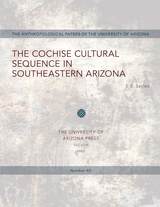
The Cochise Cultural Sequence in Southeastern Arizona
E. B. Sayles
University of Arizona Press, 1983
The Anthropological Papers of the University of Arizona is a peer-reviewed monograph series sponsored by the School of Anthropology. Established in 1959, the series publishes archaeological and ethnographic papers that use contemporary method and theory to investigate problems of anthropological importance in the southwestern United States, Mexico, and related areas.
[more]
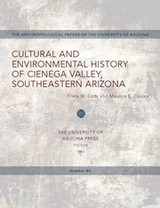
Cultural and Environmental History of Cienega Valley, Southeastern Arizona
Frank W. Eddy and Maurice E. Cooley
University of Arizona Press, 1983
The Anthropological Papers of the University of Arizona is a peer-reviewed monograph series sponsored by the School of Anthropology. Established in 1959, the series publishes archaeological and ethnographic papers that use contemporary method and theory to investigate problems of anthropological importance in the southwestern United States, Mexico, and related areas.
[more]
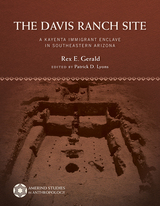
The Davis Ranch Site
A Kayenta Immigrant Enclave in Southeastern Arizona
Rex E. Gerald, Edited by Patrick D. Lyons
University of Arizona Press, 2019
In this new volume, the results of Rex E. Gerald’s 1957 excavations at the Davis Ranch Site in southeastern Arizona’s San Pedro River Valley are reported in their entirety for the first time.
Annotations to Gerald’s original manuscript in the archives of the Amerind Museum and newly written material place Gerald’s work in the context of what is currently known regarding the late thirteenth-century Kayenta diaspora and the relationship between Kayenta immigrants and the Salado phenomenon. Data presented by Gerald and other contributors identify the site as having been inhabited by people from the Kayenta region of northeastern Arizona and southeastern Utah.
The results of Gerald’s excavations and Archaeology Southwest’s San Pedro Preservation Project (1990–2001) indicate that the people of the Davis Ranch Site were part of a network of dispersed immigrant enclaves responsible for the origin and spread of Roosevelt Red Ware pottery, the key material marker of the Salado phenomenon.
A companion volume to Charles Di Peso’s 1958 publication on the nearby Reeve Ruin, archaeologists working in the U.S. Southwest and other researchers interested in ancient population movements and their consequences will consider this work an essential case study.
Annotations to Gerald’s original manuscript in the archives of the Amerind Museum and newly written material place Gerald’s work in the context of what is currently known regarding the late thirteenth-century Kayenta diaspora and the relationship between Kayenta immigrants and the Salado phenomenon. Data presented by Gerald and other contributors identify the site as having been inhabited by people from the Kayenta region of northeastern Arizona and southeastern Utah.
The results of Gerald’s excavations and Archaeology Southwest’s San Pedro Preservation Project (1990–2001) indicate that the people of the Davis Ranch Site were part of a network of dispersed immigrant enclaves responsible for the origin and spread of Roosevelt Red Ware pottery, the key material marker of the Salado phenomenon.
A companion volume to Charles Di Peso’s 1958 publication on the nearby Reeve Ruin, archaeologists working in the U.S. Southwest and other researchers interested in ancient population movements and their consequences will consider this work an essential case study.
[more]
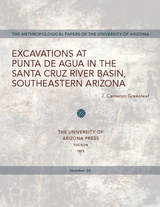
Excavations at Punta de Agua in the Santa Cruz River Basin, Southeastern Arizona
J. Cameron Greenleaf
University of Arizona Press, 1975
The Anthropological Papers of the University of Arizona No. 26. Salvage archaeology explores Indian cultural development during Rillito, Rincon, and Tanque Verde phases.
[more]
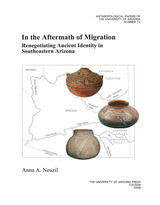
In the Aftermath of Migration
Renegotiating Ancient Identity in Southeastern Arizona
Anna A. Neuzil
University of Arizona Press, 2008
The Safford and Aravaipa valleys of Arizona have always lingered in the wings of Southwestern archaeology, away from the spotlight held by the more thoroughly studied Tucson and Phoenix Basins, the Mogollon Rim area, and the Colorado Plateau. Yet these two valleys hold intriguing clues to understanding the social processes, particularly migration and the interaction it engenders, that led to the coalescence of ancient populations throughout the Greater Southwest in the fourteenth and fifteenth centuries A.D. Because the Safford and Aravaipa valleys show cultural influences from diverse areas of the pre-Hispanic Southwest, particularly the Phoenix Basin, the Mogollon Rim, and the Kayenta and Tusayan region, they serve as a microcosm of many of the social changes that occurred in other areas of the Southwest during this time.
This research explores the social changes that took place in the Safford and Aravaipa valleys during the thirteenth through the fifteenth centuries A.D. as a result of an influx of migrants from the Kayenta and Tusayan regions of northeastern Arizona. Focusing on domestic architecture and ceramics, the author evaluates how migration affects the expression of identity of both migrant and indigenous populations in the Safford and Aravaipa valleys and provides a model for research in other areas where migration played an important role.
Archaeologists interested in the Greater Southwest will find a wealth of information on these little-known valleys that provides contextualization for this important and intriguing time period, and those interested in migration in the ancient past will find a useful case study that goes beyond identifying incidents of migration to understanding its long-lasting implications for both migrants and the local people they impacted.
This research explores the social changes that took place in the Safford and Aravaipa valleys during the thirteenth through the fifteenth centuries A.D. as a result of an influx of migrants from the Kayenta and Tusayan regions of northeastern Arizona. Focusing on domestic architecture and ceramics, the author evaluates how migration affects the expression of identity of both migrant and indigenous populations in the Safford and Aravaipa valleys and provides a model for research in other areas where migration played an important role.
Archaeologists interested in the Greater Southwest will find a wealth of information on these little-known valleys that provides contextualization for this important and intriguing time period, and those interested in migration in the ancient past will find a useful case study that goes beyond identifying incidents of migration to understanding its long-lasting implications for both migrants and the local people they impacted.
[more]
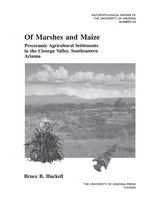
Of Marshes and Maize
Preceramic Agricultural Settlement in the Cienega Valley, Southeastern Arizona
Bruce B. Huckell
University of Arizona Press, 1995
While it was once believed that agriculture and pottery developed concurrently in prehistoric societies, modern research has concluded that agriculture preceded pottery making, since a sedentary life with greater food production led to both the need and time to create storage containers. Bruce Huckell has been at the forefront of a movement in Arizona archaeology that has greatly modified our understanding of the transition from the Archaic to the agricultural periods in the Southwest. Work done by Huckell and others at Matty Canyon has produced the most detailed account available of a Late Archaic village and has been extremely influential in suggesting that the cultivation of maize predated the appearance of pottery. Of Marshes and Maize presents archaeological information obtained from small-scale investigations at two deeply buried preceramic sites in the Cienega Creek Basin. Its report on excavations at the Donaldson Site and at Los Ojitos offers a thorough description of archaeological features and artifacts, floral and faunal remains, and their geological and chronological contexts. From this data, the author concludes that a major shift toward a sedentary lifeway dependent on maize agriculture had already occurred by Late Archaic times (c. 500 to 800 B.C.), demonstrating that previous research on late preceramic sites in this region has provided an inadequate picture of the period. This monograph represents the first full presentation in the literature of an important set of data that is well-known among researchers but has thus far not been easily accessible. It is a classic example of the use of fragmentary evidence in well-dated contexts to introduce new ideas, and will stand not only as an important record of the evidence but also as the primary reference for this significant new interpretation of the late Archaic and the introduction of agriculture into the Southwest.
[more]
READERS
Browse our collection.
PUBLISHERS
See BiblioVault's publisher services.
STUDENT SERVICES
Files for college accessibility offices.
UChicago Accessibility Resources
home | accessibility | search | about | contact us
BiblioVault ® 2001 - 2024
The University of Chicago Press









